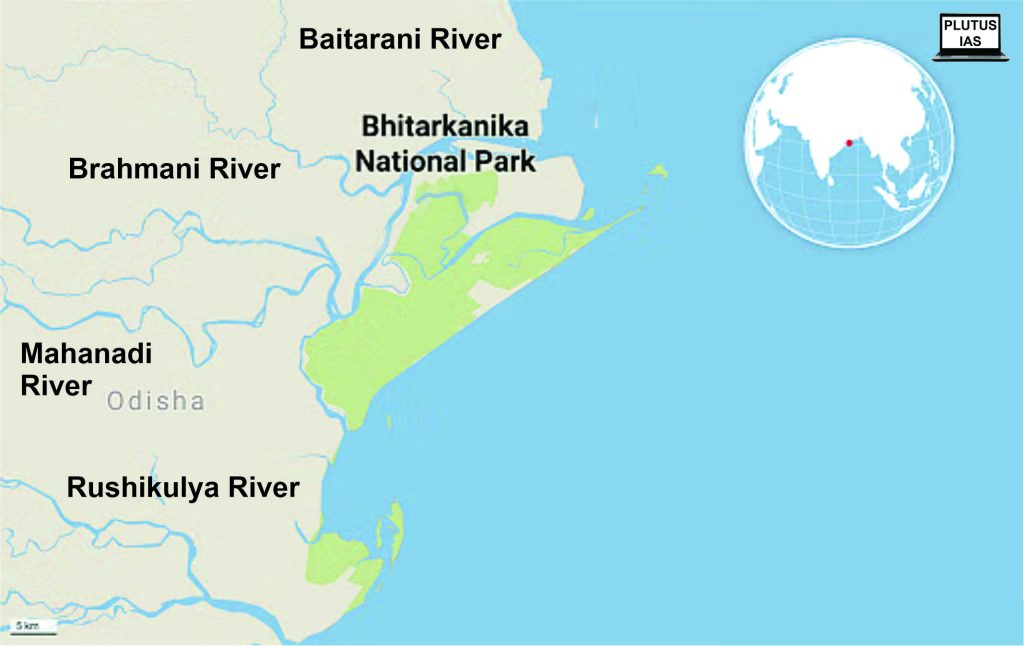22 Jan Saltwater Crocodiles
Saltwater Crocodiles
This article covers ‘Daily Current Affairs’ and the topic details of “Saltwater Crocodiles’’. This topic is relevant in the “Environment” section of the UPSC CSE exam.
UPSC MAINS GS3 Syllabus: Conservation
Why in the News?
The number of saltwater or estuarine crocodiles (Crocodylus porosus) located in and around Odisha’s Bhitarkanika National Park has increased slightly in 2024. The park in Kendrapara district has 1,811 crocodiles, as reported by forest officials who ran the annual census. Last year, there were 1,793 crocodiles.
About Saltwater Crocodile
- Saltwater crocodiles are the largest living reptiles. Males can grow to weigh 1,000-1,500 kg (2,200-3,300 lb) and reach a length of 6 m (20 ft), rarely above 6.3 m (21 ft). Females are substantially smaller, rarely exceeding 3 metres (9.8 feet).
- It is also known as the estuary crocodile, Indo-Pacific crocodile, marine crocodile, sea crocodile, or saltie colloquially. A huge and cunning hypercarnivorous dominant predator, they ambush the majority of their prey before drowning or swallowing it whole.
-
Distribution and Habitat:
- The distribution of saltwater crocodiles is very wide, encompassing the Indian subcontinent, Northern Australia, Southeast Asia, and many islands. Their broad distribution is partly due to their capacity to live in freshwater and saltwater habitats.
- They live mostly in estuarine environments, which are places where freshwater and saltwater collide. Their preferred environments are mangrove swamps, coastal marshes, and river mouths, which offer plenty of chances for nesting and hunting.
-
Prey:
- Saltwater crocodiles are apex predators, preying on a variety of aquatic and terrestrial species. Their diet includes fish, crustaceans, birds, and mammals, making them crucial for maintaining ecological balance.
- These ambush predators use patience and stealth. Partially submerged, they wait their turn before unleashing a devastating onslaught on gullible targets.
-
Conservation Status:
- IUCN Red list : Least Concern
- WPA, 1972: Schedule I
- CITES : Appendix I/II
-
Nesting:
- Female Saltwater crocodiles construct their mound nests out of mud and plants. Once they lay their eggs, they watch the nests and, when the eggs hatch, they safeguard the hatchlings, exhibiting amazing maternal instincts.
- Although they are fierce creatures, females are especially exposed when they are breeding because they are at risk from predators and habitat degradation. Protecting nesting sites is a common goal of conservation initiatives.
- They too have conservation challenges. Threats to their population include illegal hunting, habitat destruction, and confrontations between humans and wildlife
About Bhitarkanika National Park
1. Bhitarkanika is located in the northern section of the Bay of Bengal, and includes the deltas of the rivers Brahmani, Baitarani, and Dhamra. Its distinctive terrain, which includes multiple rivers and estuaries, adds to its biological significance.

2. Bhitarkanika National Park is a biodiversity hotspot known for its extensive mangrove ecosystems and unique flora and fauna.These mangroves play a pivotal role in maintaining the delicate balance of the coastal ecosystem.
3. The park is a birdwatcher’s paradise, with a diverse range of avian species. During the winter, migratory birds including herons, egrets, and kingfishers converge to Bhitarkanika, increasing the area’s ornithological attraction.
4. The Bhitarkanika estuaries provide habitat for Irrawaddy dolphins, which are endangered. The park is also an important breeding site for Olive Ridley marine turtles.
5. The Bhitarkanika national park is home to all three crocodile species: Gharial (critically endangered), Mugger crocodile (vulnerable), and Saltwater crocodile.
Download plutus ias current affairs eng med 22th Jan 2024
Prelims practice question
Q1) Consider the following statements regarding saltwater crocodile
1) Saltwater crocodiles predominantly inhabit in Estuarine ecosystems
2) IUCN has assigned them Least concern status.
Which of the following statements given above is/are correct?
- a) 1 only
- b) 2 only
- c) Both 1 and 2
- d) Neither 1 nor 2
ANSWER: C
Q2) Consider the following statements regarding river flowing in Odisha
1) Baitrani river is also known as the “river of gold” due to its golden-hued water
2) Hirakud Dam is built across Brahmani river in Odisha
3) Mangrove is the primary ecosystem found in Bhitarkanika National Park
How many statements given above are correct?
- a) One
- b) Two
- c) Three
- d) None
ANSWER: B
Mains practice questions
Q1) Identify and discuss the major challenges faced in the conservation of wildlife in India. How do factors like habitat loss and human-wildlife conflict contribute to these challenges?
Q2) Explore the role of indigenous communities in animal conservation. How can traditional knowledge and practices contribute to sustainable wildlife management?
I am a content developer and have done my Post Graduation in Political Science. I have given 2 UPSC mains, 1 IB ACIO interview and have cleared UGC NET JRF too.



No Comments